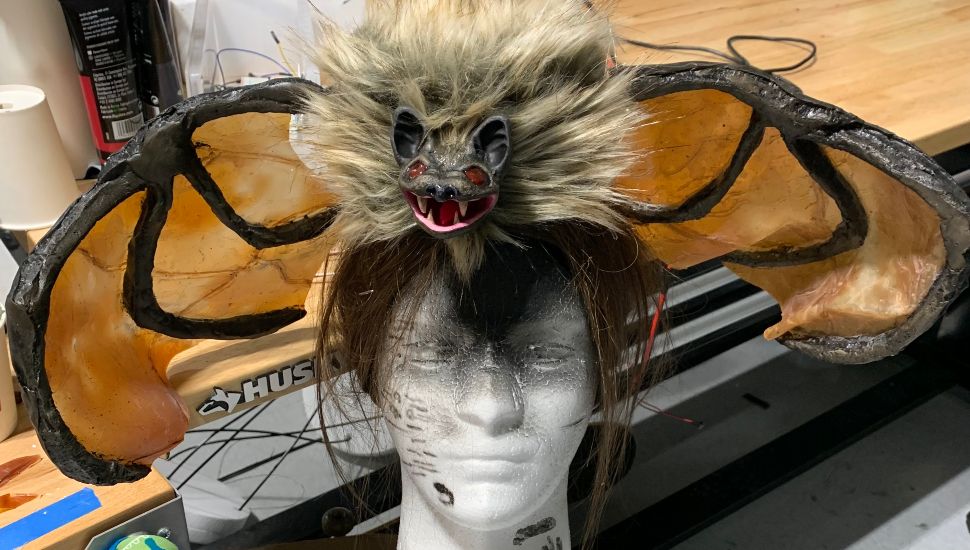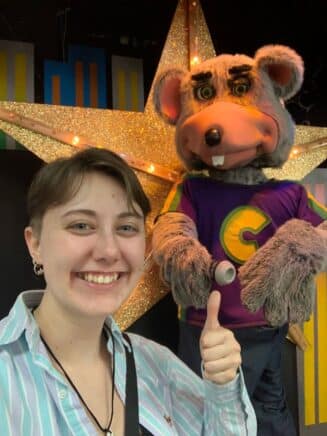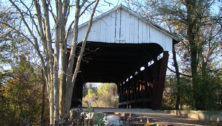Animatronics Gave Her the Platform She Needed to Bring Creatures to Life

It takes a special kind of person to be a creature creator.
Skyler James is that person.
The 23-year-old will be part of the first group graduating from a new animatronics program at the University of North Carolina School of Art.
It’s the first of its kind in the country.
Skyler is a theater person, and though she did some acting in high school, she prefers hands-on work in costume design and props. She ended up double majoring in studio art and technical theater at James Madison University.
When it came time for graduate school, she couldn’t decide whether to focus on costuming or props. The animatronics program at North Carolina had a bit of both.
She was intrigued.
“They didn’t need me to hem a pair of pants, but do you know how to build a mask that talks?”
Unlike others who might pursue animatronics for its technical work, Skyler liked the artistic challenge of creating a character from scratch, of bringing something into the world that doesn’t exist.
A child in a family of big “Star Wars” fans, she understood how puppetry and fantasy characters featured prominently in the entertainment industry and in theme parks.
Skyler’s love of the arts and sciences had always been encouraged by her family.
Her father, David James, has a theater background and now is chief development officer for the Friends Association of Chester County.
Skyler’s younger brother, Austin, is studying theater at the University of Pittsburgh, while her mom has a passion for teaching.
Skyler grew up fascinated by the idea of art and technology coming together as she watched her simple flip phone morph into a multi-tasking, personalized iPhone.
She sees animatronics as the latest intersection of art and technology.

“You can build a robot, but how do you also make that robot look good and communicate a story, a character, for example?”
Skyler does figure finishing work—painting or covering the animatronic object with clothing or other materials to hide the technology underneath and to give the object its identity.
Some examples of her work to date include creating costume mechanics for a 2021 production of “A Midsummer Night’s Dream,” a design that earned her a 2022 KCACTF Region 2 First Place Award for Costume Design.
She’s also created a wearable costume/prop that simulates a realistic bat flying around the head of the wearer.
“I wanted to see how far you could push it to be sort of this realistic critter that you wear, and it ended up being attached to a wig so you could wear it on your head. You had to perform with it so you could have it for film or theater or even in the park wearing it as a character actor,” Skyler said.
Her North Carolina animatronics team was also called in to help with a University of North Carolina independent student horror film project. The team designed the main creature, nicknamed “Dredgee,” that is the focus of the film.
“It was about 15 feet tall, and it moved on this spire to rock back and forth. It gets all sorts of creepy movement,” she said. “I helped build the mechanism for that as well as 12 tentacles.”

Chuck E. Cheese
For most Americans, their first experience with animatronics comes from visits to Disneyland and Disney World. Walt Disney and his team advanced animatronics in the United States in the 1950s through the 70s when they populated their theme parks with figures that could speak and move, like the figures found in Disney’s Hall of Presidents.
Then, of course, there’s Chuck E. Cheese.
When your family couldn’t make it to Disney World, you could always catch the animatronic show at Chuck E. Cheese while chowing down on some pizza.
Chuck E. Cheeses are still around, but like everywhere else, they were hit hard by the pandemic and filed for Chapter 11 bankruptcy.
A decision was made at the corporate level to start retiring the animatronic shows because they either weren’t being used or there was no money to repair and maintain them.
Now Skyler is utilizing an art grant from a proposal she wrote to preserve as much information about those animatronic shows as she can in a reference book.
She’s studying the animatronic figures installed from 1989 to 1991 at various Chuck E. Cheeses in the U.S., talking with experts and researching online.
“They’ve got some years on them. That’s what was fascinating to me, how well they were kept through time or what has worn out, or what’s left to find,” Skyler said.
Because these are older animatronics, the technology, and methods used to make it work are of interest to those in the field today.
“Somebody who worked for Chuck E. Cheese showed that their animatronics were run via floppy disc, which has not been used for an extremely long time,” Skyler said.
Skyler’s in a bit of a race to get her information preserved before Chuck E. Cheese retires its entire line of animatronic figures by 2025.
As of last January, there were only 160 Chuck E. Cheese stores out of 500 that still had the animatronic shows.
And what started as a summer art grant project will probably turn into a thesis, Skyler added.
An Animatronics Career
People can have a career in animatronics even with different backgrounds. In her graduating class, there was an engineer, someone with a master’s in coding, and Skyler, with her theater background.
“It all wonderfully combines to make this a really cool career,” she said.
And, she added, they are always looking for more students.
Connect With Your Community
Subscribe to stay informed!
"*" indicates required fields


















![95000-1023_ACJ_BannerAd[1]](https://vista.today/wp-content/uploads/2023/03/95000-1023_ACJ_BannerAd1.jpg)





























